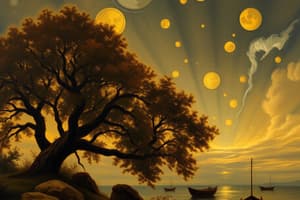Podcast
Questions and Answers
What role does acetyl-CoA carboxylase (ACC) play in fatty acid synthesis?
What role does acetyl-CoA carboxylase (ACC) play in fatty acid synthesis?
- It is the rate limiting step in fatty acid synthesis. (correct)
- It inhibits ATP production.
- It activates fatty acid breakdown.
- It promotes glucose metabolism.
How does a high concentration of AMP affect acetyl-CoA carboxylase (ACC)?
How does a high concentration of AMP affect acetyl-CoA carboxylase (ACC)?
- It activates ACC directly.
- It increases the synthesis of fatty acids.
- It has no effect on ACC.
- It inhibits ACC through AMPK activation. (correct)
What occurs when the ADP:ATP ratio increases?
What occurs when the ADP:ATP ratio increases?
- Energy levels in the cell improve.
- Adenylate kinase reaction is displaced to produce ATP. (correct)
- AMPK is inactivated.
- AMP concentration decreases.
What is primarily produced from acetyl-CoA and malonyl-CoA in fatty acid synthesis?
What is primarily produced from acetyl-CoA and malonyl-CoA in fatty acid synthesis?
What happens to AMPK in the presence of insulin?
What happens to AMPK in the presence of insulin?
What does a high carbohydrate meal stimulate in the body?
What does a high carbohydrate meal stimulate in the body?
How is ATP mainly generated in animal cells?
How is ATP mainly generated in animal cells?
What is the consequence of not maintaining a balance between ATP generation and consumption?
What is the consequence of not maintaining a balance between ATP generation and consumption?
Where does catabolism of fatty acids primarily occur?
Where does catabolism of fatty acids primarily occur?
Which enzyme is the rate limiting step in fatty acid synthesis?
Which enzyme is the rate limiting step in fatty acid synthesis?
What role does insulin play in fatty acid synthesis?
What role does insulin play in fatty acid synthesis?
Where are the enzymes involved in triglyceride biosynthesis primarily found?
Where are the enzymes involved in triglyceride biosynthesis primarily found?
What is the primary source of acetyl-CoA in the cytoplasm for fatty acid synthesis?
What is the primary source of acetyl-CoA in the cytoplasm for fatty acid synthesis?
Which organelles are crucial for lipid storage?
Which organelles are crucial for lipid storage?
What process couples deacetylation in the mitochondria with acetylation in the cytosol?
What process couples deacetylation in the mitochondria with acetylation in the cytosol?
What promotes the production of citrate and acetyl-CoA in the cytosol?
What promotes the production of citrate and acetyl-CoA in the cytosol?
Which enzyme is primarily responsible for the final step in triglyceride synthesis in the endoplasmic reticulum?
Which enzyme is primarily responsible for the final step in triglyceride synthesis in the endoplasmic reticulum?
What type of lipids are predominantly synthesized in the endoplasmic reticulum in eukaryotic cells?
What type of lipids are predominantly synthesized in the endoplasmic reticulum in eukaryotic cells?
Which pathway is considered the primary pathway for triglyceride synthesis?
Which pathway is considered the primary pathway for triglyceride synthesis?
What is the function of ACAT enzymes found in the endoplasmic reticulum?
What is the function of ACAT enzymes found in the endoplasmic reticulum?
In which type of cells is the monoacylglycerol pathway particularly important for triglyceride synthesis?
In which type of cells is the monoacylglycerol pathway particularly important for triglyceride synthesis?
What role do MGAT enzymes play in triglyceride synthesis?
What role do MGAT enzymes play in triglyceride synthesis?
Which of the following statements about triglycerides (TGs) is correct?
Which of the following statements about triglycerides (TGs) is correct?
What happens to the lipids stored in lipid droplets?
What happens to the lipids stored in lipid droplets?
What structural characteristic differentiates microvesicular steatosis from macrovesicular steatosis in hepatocytes?
What structural characteristic differentiates microvesicular steatosis from macrovesicular steatosis in hepatocytes?
Which hormone is primarily responsible for the growth of glycogen granules in the fed state?
Which hormone is primarily responsible for the growth of glycogen granules in the fed state?
How does glucagon affect glycogen granules during fasting?
How does glucagon affect glycogen granules during fasting?
What is the primary function of glycogen in muscle cells?
What is the primary function of glycogen in muscle cells?
What role does insulin play in glucose homeostasis?
What role does insulin play in glucose homeostasis?
What happens to glycogen in the liver during prolonged fasting?
What happens to glycogen in the liver during prolonged fasting?
What would likely occur if glucose-6-phosphatase were deleted?
What would likely occur if glucose-6-phosphatase were deleted?
Which cellular structure is typically associated with glycogen granules?
Which cellular structure is typically associated with glycogen granules?
Flashcards are hidden until you start studying
Study Notes
Insulin and Fatty Acid Synthesis
- High carbohydrate meals stimulate insulin secretion
- Insulin activates fatty acid synthesis
- High carbohydrates lead to increased production of citrate and acetyl-CoA in the cytosol
- Acetyl-CoA carboxylase (ACC) is the rate-limiting step in fatty acid synthesis
- ACC is inhibited by AMP-activated protein kinase (AMPK)
- AMPK is activated when the AMP/ADP ratio is high.
- AMP/ADP ratio increases when glucose levels are high
- AMPK phosphorylates ACC, inhibiting its activity, therefore decreasing fatty acid synthesis
- AMPK is inactive in the presence of insulin
Fatty Acid Synthesis: Palmitic Acid Synthesis
- Fatty acid synthesis starts with the formation of palmitic acid (C16) from acetyl-CoA and malonyl-CoA
- Malonyl-CoA is a 3-carbon molecule formed from acetyl-CoA
- Fatty acid synthesis occurs in the cytoplasm.
- Fatty acid synthase, a multi-enzyme complex, is found in the cytoplasm
- Acetyl-CoA for fatty acid synthesis is derived from the mitochondrial acetyl-CoA through the citrate-malate shuttle
Triglyceride Biosynthesis
- Acyl-CoA can include fatty acids like palmitate, forming palmitoyl-CoA
- Triglyceride biosynthesis occurs in the smooth endoplasmic reticulum (ER)
- Enzymes involved in triglyceride biosynthesis are located in the ER
- Lipid droplets are formed by budding from the ER.
- Lipid droplets store lipids long-term.
- DGAT enzymes catalyze the terminal step in triglyceride synthesis.
- ACAT enzymes synthesize cholesterol esters in the ER.
- Cholesterol esters can be stored in lipid droplets.
Lipid Droplets
- Lipid droplets are organelles for lipid storage
- Lipids stored include cholesterol esters and triglycerides.
Glycerophospholipid and Triglyceride Synthesis
- Glycerophospholipids and triglycerides are classified as neutral lipids (no charge, insoluble in water)
- Glycerophospholipids and triglycerides are synthesized in the ER
- The Kennedy pathway is the primary pathway for triglyceride synthesis
- The Kennedy pathway utilizes glycerolphosphate and fatty acyl-CoA to produce glycerolipids
- A second pathway for triglyceride synthesis, the monoacylglycerol pathway, exists in some cells types
- The monoacylglycerol pathway recycles mono- and diarylglycerols back into triglycerides
Liver Histology
- Liver steatosis refers to abnormal lipid accumulation in hepatocytes.
- Microvesicular steatosis is characterized by small lipid droplets and preserved cell structure.
- Macrovesicular steatosis exhibits large lipid droplets that displace the nucleus.
Dietary Carbohydrates and VLDL Production
- Increased dietary carbohydrate intake leads to increased production of very-low-density lipoprotein (VLDL)
- VLDL is a plasma triglyceride
Glucose Homeostasis
- Glucose homeostasis is maintained by insulin and glucagon.
- Insulin and glucagon are hormones.
Glycogen Granules
- Glycogen is stored as granules in cells
- Glycogen granules increase in size during the fed state, regulated by insulin
- Glycogen granules decrease in size during the fasting state, regulated by glucagon.
- Liver glycogen is a glucose source for gluconeogenesis
- Muscle glycogen provides energy for ATP synthesis.
Glucose-6-Phosphatase Deficiency
- Glucose-6-phosphatase is an enzyme involved in glucose metabolism
- Deletion of glucose-6-phosphatase would lead to a clinical manifestation known as von Gierke disease.
- Clinical features of von Gierke disease include hypoglycemia, hepatomegaly, and lactic acidosis.
Studying That Suits You
Use AI to generate personalized quizzes and flashcards to suit your learning preferences.




